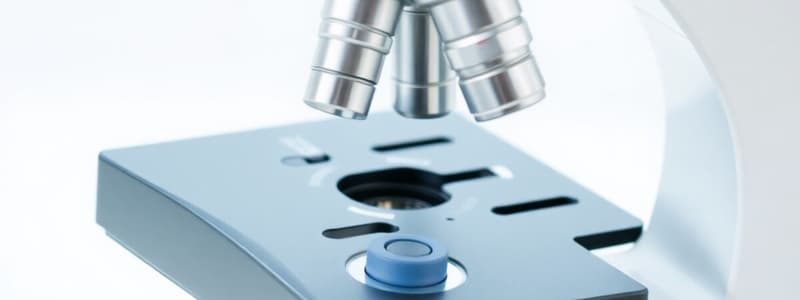Podcast
Questions and Answers
What is the main purpose of aseptic technique in microbiology?
What is the main purpose of aseptic technique in microbiology?
- To prevent contamination of samples. (correct)
- To improve the resolution of a microscope.
- To enhance the staining process.
- To increase the growth of organisms.
Which of the following best describes the function of basic dyes in microscopy?
Which of the following best describes the function of basic dyes in microscopy?
- They stain the background leaving the cells clear.
- They are exclusively used for staining fungi.
- They have low affinity for cellular materials.
- They bind to negatively charged cell components. (correct)
In gram staining, what is the role of the decolorizer?
In gram staining, what is the role of the decolorizer?
- To fix the stain within the bacterial cells.
- To remove color from both types of bacteria.
- To differentiate between gram-positive and gram-negative bacteria. (correct)
- To enhance the color of gram-positive bacteria.
What term describes the maximum temperature at which a mesophilic organism can grow?
What term describes the maximum temperature at which a mesophilic organism can grow?
Which of the following characteristics differentiates fungi from bacteria?
Which of the following characteristics differentiates fungi from bacteria?
What is the significance of the zone of inhibition in the Kirby-Bauer method?
What is the significance of the zone of inhibition in the Kirby-Bauer method?
What is the main function of agar in culture media?
What is the main function of agar in culture media?
Which of the following organisms is most commonly stained using the acid-fast staining method?
Which of the following organisms is most commonly stained using the acid-fast staining method?
What is one of the reasons spores are resistant to ordinary staining methods?
What is one of the reasons spores are resistant to ordinary staining methods?
How do heterotrophs obtain energy?
How do heterotrophs obtain energy?
What is the main characteristic that differentiates protozoa from algae?
What is the main characteristic that differentiates protozoa from algae?
What is the purpose of heat-fixing a slide during smear preparation?
What is the purpose of heat-fixing a slide during smear preparation?
Which type of media is primarily used to isolate specific organisms based on their nutritional requirements?
Which type of media is primarily used to isolate specific organisms based on their nutritional requirements?
What does the term 'parfocalization' refer to in microscopy?
What does the term 'parfocalization' refer to in microscopy?
Which of the following characteristics is NOT typical of endospores?
Which of the following characteristics is NOT typical of endospores?
What is the primary method used to determine bacterial motility in a laboratory setting?
What is the primary method used to determine bacterial motility in a laboratory setting?
Which statement regarding gram-positive and gram-negative bacteria is true?
Which statement regarding gram-positive and gram-negative bacteria is true?
What is a characteristic feature of cyanobacteria?
What is a characteristic feature of cyanobacteria?
In which type of staining does one stain clearly differentiate between different types of bacteria?
In which type of staining does one stain clearly differentiate between different types of bacteria?
Which definition best describes 'autotrophs'?
Which definition best describes 'autotrophs'?
What is the defining characteristic of dimorphic fungi?
What is the defining characteristic of dimorphic fungi?
Which of the following terms defines the accuracy of the microscope in distinguishing two close points?
Which of the following terms defines the accuracy of the microscope in distinguishing two close points?
In the context of bacterial morphology, what does the term 'cocci' refer to?
In the context of bacterial morphology, what does the term 'cocci' refer to?
What is the primary reason that spores are not stained using ordinary methods?
What is the primary reason that spores are not stained using ordinary methods?
What does the hanging drop method primarily determine?
What does the hanging drop method primarily determine?
What are the primary constituents of a culture medium that serves as the growth substrate for microorganisms?
What are the primary constituents of a culture medium that serves as the growth substrate for microorganisms?
Which statement best differentiates selective media from differential media?
Which statement best differentiates selective media from differential media?
What is the basis of the gram staining classification of bacteria?
What is the basis of the gram staining classification of bacteria?
Which of the following accurately describes the function of agar in culture media?
Which of the following accurately describes the function of agar in culture media?
What is the primary characteristic that differentiates fungi from bacteria?
What is the primary characteristic that differentiates fungi from bacteria?
What does the resolving power of a microscope refer to?
What does the resolving power of a microscope refer to?
Which bacterial morphology describes a cluster of spherical bacteria?
Which bacterial morphology describes a cluster of spherical bacteria?
What is the primary reason for using the Schaeffer-Fulton method to stain endospores?
What is the primary reason for using the Schaeffer-Fulton method to stain endospores?
What is the main purpose of using selective media in microbiology?
What is the main purpose of using selective media in microbiology?
In differential staining, what characteristic is primarily used to differentiate bacteria?
In differential staining, what characteristic is primarily used to differentiate bacteria?
What is indicated by the zone of inhibition in the Kirby-Bauer method?
What is indicated by the zone of inhibition in the Kirby-Bauer method?
Which of the following statements accurately describes the function of agar in culture media?
Which of the following statements accurately describes the function of agar in culture media?
What is the primary role of the decolorizer in the gram staining procedure?
What is the primary role of the decolorizer in the gram staining procedure?
Which characteristic is NOT typical of fungi?
Which characteristic is NOT typical of fungi?
What defines the term 'autotroph' in microbiology?
What defines the term 'autotroph' in microbiology?
Flashcards
Compound microscope parts
Compound microscope parts
A compound microscope is a microscope with multiple lenses, each contributing to the image magnification. The parts contain the eyepiece, objective lens, stage, condenser, and light source. Each part has a specific role in viewing samples
Resolving power
Resolving power
The ability of a microscope to distinguish between two closely spaced points as separate entities. Higher resolution means it can see finer details.
Bacterial morphology
Bacterial morphology
The shape of bacteria. This includes coccus (spherical), bacillus (rod-shaped), and spiral.
Aseptic technique
Aseptic technique
Signup and view all the flashcards
Gram stain procedure
Gram stain procedure
Signup and view all the flashcards
Selective media
Selective media
Signup and view all the flashcards
Differential media
Differential media
Signup and view all the flashcards
Autoclaving
Autoclaving
Signup and view all the flashcards
Pure culture
Pure culture
Signup and view all the flashcards
Antiseptics
Antiseptics
Signup and view all the flashcards
Working distance
Working distance
Signup and view all the flashcards
Total magnification
Total magnification
Signup and view all the flashcards
Parfocalization
Parfocalization
Signup and view all the flashcards
Protozoa characteristics
Protozoa characteristics
Signup and view all the flashcards
Algae characteristics
Algae characteristics
Signup and view all the flashcards
Cyanobacteria characteristics
Cyanobacteria characteristics
Signup and view all the flashcards
Aseptic technique significance
Aseptic technique significance
Signup and view all the flashcards
Fungi characteristics
Fungi characteristics
Signup and view all the flashcards
Yeast vs. mold
Yeast vs. mold
Signup and view all the flashcards
Smear Preparation
Smear Preparation
Signup and view all the flashcards
Simple Staining
Simple Staining
Signup and view all the flashcards
Differential Staining
Differential Staining
Signup and view all the flashcards
Basic Dyes
Basic Dyes
Signup and view all the flashcards
Acidic Dyes
Acidic Dyes
Signup and view all the flashcards
Capsule
Capsule
Signup and view all the flashcards
Study Notes
Microscopy
- Compound Microscope Parts & Functions: (Detailed diagrams recommended for full understanding)
- Eyepiece/ocular: Magnifies the image.
- Objective lenses: Magnify the image, varying magnification for different lenses.
- Stage: Supports the specimen.
- Condenser: Focuses light on the specimen.
- Diaphragm: Controls light intensity.
- Coarse adjustment knob: Moves stage for initial focusing.
- Fine adjustment knob: Precisely focuses the image.
- Arm: Supports the microscope body.
- Base: Provides support.
- Resolving Power: Ability to distinguish between two closely spaced points.
- Working Distance: Distance between the objective lens and the specimen.
- Total Magnification: Product of eyepiece and objective lens magnification.
- Parfocalization: A microscope that maintains focus when changing magnification.
Microscopy Resolution
- Resolution is the ability to distinguish between two closely spaced points.
Microbial Characteristics
- Protozoa: Eukaryotic, animal-like, single-celled organisms.
- Algae: Eukaryotic, photosynthetic, single-celled or multicellular (often aquatic).
- Cyanobacteria: Prokaryotic, photosynthetic, single-celled or filamentous organisms (blue-green algae).
Aseptic Technique
- Vital for preventing contamination during microbiological procedures.
Bacterial Characteristics
- Prokaryotic: Lack a nucleus and membrane-bound organelles.
- Bacterial Morphology (Fig. 8.1): Consider shapes (cocci, bacilli, spirilla) and arrangements (chains, clusters).
Fungal Characteristics
- Eukaryotic: Possess a nucleus and other membrane-bound organelles.
- Yeast: Unicellular, oval or spherical.
- Mold: Multicellular, filamentous (hyphae). Differences: growth form, structure.
Mycology, Myceteae, Dimorphic
- Mycology: The study of fungi.
- Myceteae: Fungi, (fungal family group)
- Dimorphic: Fungi exhibiting two distinct morphological forms in different conditions.
Smear Preparation
- Liquid Media: Prepare smear by taking a loopful of liquid culture, placing it on the slide, and air-drying.
- Solid Media: Use a sterile loop to lightly emulsify a small amount of solid media, placing it on the slide, and air-drying.
Heat-Fixing
- Purpose: Kills the cells and adheres them to the slide.
Staining
- Simple Staining: Uses a single dye to visualize cell morphology.
- Differential Staining: Uses multiple dyes to distinguish between cell types (e.g., Gram stain, acid-fast stain).
Basic and Acidic Dyes
- Basic Dyes: Positively charged dyes that bind to negatively charged cell components (like cell membranes).
- Acidic Dyes: Negatively charged dyes that bind to parts with positive charges.
Capsule
- Definition: Gelatinous layer surrounding some bacteria.
- Difficulty Staining: The capsule is not strongly visible due to the nature of its structure against typical staining methods.
Gram Staining
- Procedure: Specific steps involving crystal violet, iodine, decolorizer (alcohol/acetone), and safranin.
- Gram-Positive: Retain crystal violet; appear purple.
- Gram-Negative: Lose crystal violet and stain red with safranin.
- Basis: Differences in cell wall structures.
Endospores
- Functions: A resting, dormant structure allowing survival under adverse conditions. Resistance to heat, chemicals, etc.
- Producing Genera: Bacillus, Clostridium.
- Staining: Using Schaeffer-Fulton method, spores stain differentially to differentiate them from the vegetative body of the bacteria.
Acid-Fast Staining
- Medical Importance: Differentiate acid-fast bacteria (e.g., Mycobacterium) from non-acid-fast organisms; important for diagnosis.
- Characteristics: Presence of waxy mycolic acid in the cell wall. Resist decolorization.
- Procedure: Use of carbolfuchsin, acid-alcohol to decolorize, and methylene blue as a counterstain.
Motility Determination
- Hanging Drop Method: Direct observation of bacterial movement in a hanging drop of liquid culture medium.
- Tube Method: Observe motility by observing cloudiness in a liquid medium of culture.
Culture Media
- Definition: Nutrient solutions containing specific compounds required for microbial growth.
- Agar: Solidifying agent in culture media.
Microbial Nutrition
- Autotrophs: Obtain carbon from inorganic sources.
- Heterotrophs: Obtain carbon from organic sources.
- Photoautotrophs: Use light for energy, inorganic carbon as a carbon source.
- Chemoautotrophs: Obtain energy from inorganic chemicals, inorganic carbon as a carbon source.
- Chemoheterotrophs: Obtain energy and carbon from organic sources.
- Photoheterotrophs: Use light for energy, organic carbon as a carbon source.
- Growth Factors: Organic compounds required by some bacteria for growth.
- Synthetic Media: Defined chemical composition.
- Non-synthetic Media: Complex, undefined ingredients (examples: blood agar, nutrient agar).
Selective and Differential Media
- Selective Media: Allows growth of specific organisms because it inhibits to select others.
- Differential Media: Allow differentiation of organisms based on their metabolic reactions (e.g., changes in color, gas production).
Autoclaving
- Time and Temperature: Standard autoclaving conditions for sterilization.
Pure Culture Isolation
- Methods: Techniques for isolating pure cultures based on streaking the colonies and selection of single colonies.
Quantitative Plating
- Countable Plate: Plate with a number of colonies that can be readily counted.
Microbial Growth Conditions
- Optimum Temperature: Ideal temperature for growth.
- Maximum Temperature: Highest temperature for growth.
- Minimum Temperature: Lowest temperature.
- Mesophiles: Organisms growing best at moderate temperatures.
- Psychrophiles: Organisms growing best at low temperatures.
- Thermophiles: Organisms growing best at high temperatures.
- Thermal Death Time: Time required to kill all microbes.
- Thermal Death Point: Lowest temperature at which all microbes are killed in a given time.
- Hypotonic, Hypertonic, Isotonic: Solutions differing in solute concentration relative to cells.
- Plasmolysis: Shrinking of cells due to hypertonic solution conditions.
- Osmophiles: Organisms growing best at high osmotic pressure.
- Halophiles: Organisms growing best in high salt concentrations.
Cellular Response to Environments
- Hypotonic: Cells swell and may burst.
- Hypertonic: Cells shrink and lose water.
Antimicrobial Agents
- Antiseptics: Used on living tissues to prevent infection.
- Disinfectants: Used to eliminate microorganisms from inanimate objects.
- Antibiotics: Chemicals produced by microorganisms that kill or inhibit the growth of other microorganisms.
Zone of Inhibition
- Definition: Area around an antibiotic disk where bacterial growth is inhibited.
Kirby-Bauer Method
- Method: Standard procedure for determining the sensitivity or resistance of bacteria to antimicrobial agents.
Microbial Metabolism
- Fermentation: Metabolic process yielding energy under anaerobic conditions.
- Metabolism: All chemical reactions within an organism.
- Endoenzymes: Enzymes acting within the cell.
- Exoenzymes: Enzymes acting outside the cell.
- Oxidation: Loss of electrons.
Biochemical Tests
- Detailed descriptions of media, reagents, expected results, positive reactions. (You'll need to consult individual descriptions of these tests).
- Durham tube sugar fermentation.
- Mixed acid fermentation.
- Butanediol fermentation.
- Catalase production.
- Oxidase production.
- Starch hydrolysis.
- Casein hydrolysis.
- Fat hydrolysis.
- Tryptophan hydrolysis.
- Urea hydrolysis.
- Hydrogen sulfide production.
- Citrate utilization.
- IMViC test
- Phenylalanine deamination.
Enzyme Function
- Specific functions relating catalase, urease, amylase, lipase, tryptophanase, (need additional specifics on function)
Additional Notes
- Review figures as specifically stated. Study the appearance of microorganisms and results, and note the correct use of aseptic technique in all procedures.
Studying That Suits You
Use AI to generate personalized quizzes and flashcards to suit your learning preferences.




